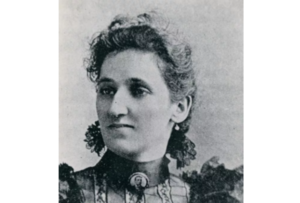Victoria Earle Matthews, Journalist, Author, and Social Worker

By Dan Gore
Victoria Earle Matthews was a journalist, author, clubwoman, and social worker. She was born a slave in Fort Valley Georgia. Her mother Caroline Smith was said to have been a Virginian. Her white father was so cruel that her mother fled to New York, leaving her nine children with an old nurse. After emancipation, Caroline Smith returned to Georgia, where she found Victoria and three other of her children being reared in their white father’s household. After “considerable legal trouble, she succeeded in gaining possession of her children, and returned with them to New York, stopping on the way at Richmond and Norfolk.”
She attended grammar school 48 in New York City but was soon forced to seek employment as a domestic worker. She was thereafter largely self-taught, using the library of the house in which she worked. She was first a “sub” for reporters on the large dailies of New York City, later for other newspapers and magazines. In 1879 she married William Matthews, a coachman, and settled in Brooklyn with their one son, Lamartine. In 1892 Mrs. Matthews became the first president of the Women’s Loyal Union of New York, and in 1895, with Josephine St. Pierre Ruffin and others, helped found in Boston the National Federation of Afro American Women. She was the principal planner of the meeting in Washington, D.C., when the federation merged with the National Colored Women’s League, organized by Mary Church Terrell, to become the National Association of Colored Women. Under Terrell, its first president, Matthews served (1897-1899) as national organizer.
Meanwhile, after the death of her son at age sixteen and with her growing concern for colored girls who were lured into becoming prostitutes, she shifted her interest to social welfare. She attended the Congress of Colored Women of the United States at the Atlanta exposition (1895) and toured the South, especially New Orleans, to investigate the “red-light” districts and the “employment agencies” which found “jobs” for colored girls in the North. In 1897 she founded the White Rose Industrial Association and opened the White Rose Mission as a social center for Black female migrants who settled in the tenements of New York’s Upper East Side. The mission trained the newcomers and found employment for them as domestic servants. White Rose agents watched the piers in New York and Norfolk, Va., to prevent colored girls from becoming victims of a “white slave” racket. After T. Thomas Fortune persuaded Booker T. Washington to visit the ramshackle mission, Washington spoke at a fund-raising dinner which helped make possible the opening of a larger mission on 86th Street. This was like other settlement houses of the era with mothers’ clubs, recreational facilities, and a kindergarten. Matthews was a pioneer there in teaching a class in Black history and establishing a large library of books by and about Black people. When her health began to fail, her duties were taken over by able assistants.
She died in New York City of tuberculosis at the age of forty-five, and was buried in Maple Grove Cemetery, Kew Gardens, Long Island City. The White Rose mission later moved to 136th Street in Harlem, where a plaque commemorates her life and work.

© Copyright 2022 - The New 3Rs | Privacy Policy | Terms of Use
Recent Comments